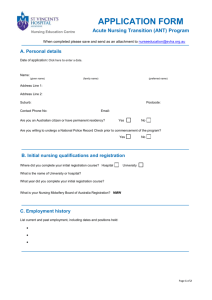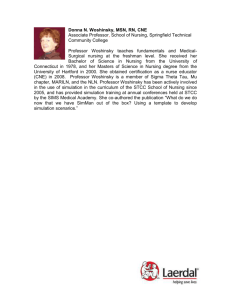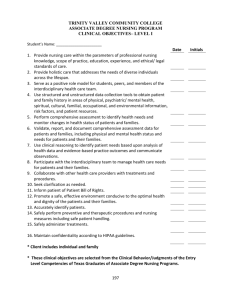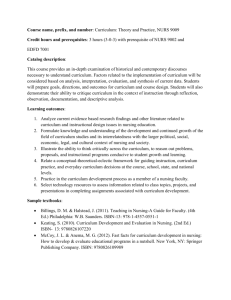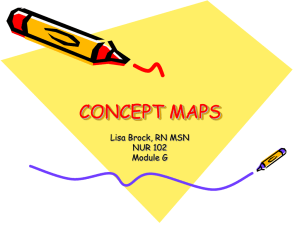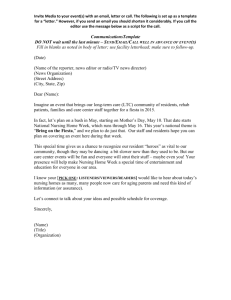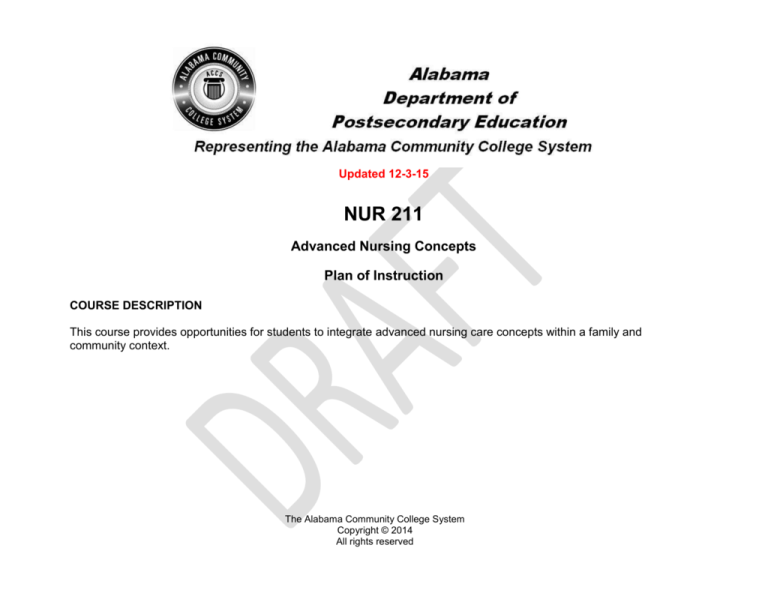
Updated 12-3-15
NUR 211
Advanced Nursing Concepts
Plan of Instruction
COURSE DESCRIPTION
This course provides opportunities for students to integrate advanced nursing care concepts within a family and
community context.
The Alabama Community College System
Copyright © 2014
All rights reserved
NUR 211 – Advanced Nursing Concepts
Plan of Instruction
CREDIT/CONTACT HOURS BREAKOUT
Type
Theory
Lab
Clinical
Total
Credit Hours
4
0
3
Contact Hours
60
0
135
Minimum Topics
As per exemplars
Applied concepts lab
16 contact hours are used for mental health clinical and 87 contact hours
for complex adult health clinical, 16 contact hours in pediatrics, 16 contact
hours in maternal/infant.
7 credit hours – 13 contact hours per week
NOTE: Theory credit hours are a 1:1 contact to credit ratio. Lab and clinical hours as are 3:1 contact to credit ratio. (Ref Board
Policy 705.01)
PREREQUISITE COURSES
CO-REQUISITE COURSES
NUR 114 – Nursing Concept II
NUR 115 – Evidence Based Clinical Reasoning
SPH 106 or 107 - Speech
BIO 220 – General Microbiology
COURSE STUDENT LEARNING OUTCOMES
Course student learning outcomes specified within this course are reflective of current NLN and QSEN graduate
competencies for the Associate Degree Nurse.
.
2
ACCS Copyright© 2014
All rights reserved
NUR 211 – Advanced Nursing Concepts
Plan of Instruction
STUDENT LEARNING OUTCOMES
Individual Domain (Human Flourishing/Nursing Judgment)
Graduate Competencies
Student Learning Outcomes
NLN
Nursing
Integrate advanced concepts to provide nursing
judgment
care inherent to the individual domain within a
Spirit of
family and community context.
inquiry
Human
Concepts:
flourishing
Reproduction
Professional
Sensory Perception
identity
Violence
Assessment findings
QSEN
Safety
Intracranial Regulation
Informatics
Perfusion
Evidenced
Fluid/electrolyte balance
based
Immunity
practice
Cellular regulation
Patient
Emergent care
centered care
Teamwork
and
collaboration
Quality
improvement
Objectives
Utilize elements of clinical decision making for
patients with selected health concepts and
alterations.
Explain health promotion, specialized
modalities and pharmacological agents for
patients with selected health concepts and
alterations.
Discuss clinical manifestations and diagnostic
tests for patients with selected health
concepts and alterations.
Prioritize nursing interventions for patients
with selected health concepts and alterations.
KSA
3
3
3
3
3
ACCS Copyright© 2014
All rights reserved
NUR 211 – Advanced Nursing Concepts
Plan of Instruction
Individual Domain (Human Flourishing/Nursing Judgment) - Continued
Exemplars:
Manager of Care
Perfusion
Basic pathophysiology
o Coronary artery disease
Assessment
Myocardial infarction
Nursing interventions
Advanced EKG strip interpretation
Diagnostics
o Congenital heart defects
Evidenced base Practice
o Valve disorders
Cultural considerations
o Rheumatic fever
Specialized modalities
o Shock
Common drug classifications
o Pulmonary hypertension
Nutritional considerations
o Hemodynamic monitoring
Health promotion/prevention of
o Balloon Pumps
complications
o CABG
Community base nursing care
o Transplants
Informatics
o Pacemakers
Teaching and Learning
o Shock
Scope of practice
o DIC
Growth & Development
o VAD
o High risk OB
Cellular Regulation
Preterm labor and delivery
o Increased intracranial pressure
Preterm newborn
o Meningitits
Preeclampsia
o Gillian-Barre Syndrome
Eclampsia
o Spina bifida
Prolapsed cord
o Hydrocephaly
Placenta previa
o SIADH
Placenta abruptio
o Diabetes Insipidus
Precipitus delivery
Medical Emergency
Postpartal hemorrhage
o Multiple organ dysfunction (MODs)
Postpartum psychosis
o Traumatic Brain Injury
Multiple gestation
o Spinal Cord Injury
Congenital/birth complications
o Hyperthermia
Substance abuse
o Hypothermia
Psychosocial Well-being
o Burns
o Abuse
o Sepsis
o Suicide
o Epiglottitis
o Cutting disorders
Oxygenation
o Rape trauma
o Respiratory distress syndrome
o Unintentional injury or trauma
o
Ventilation
o Bronchopulmonary dysplasia
o Hemothorax
o Pneumothorax
o
Chest tubes
Lung surgery
ABG’s
Safety
o Triage
o Disaster triage
o Bioterrism
o Trauma
4
ACCS Copyright© 2014
All rights reserved
NUR 211 – Advanced Nursing Concepts
Plan of Instruction
STUDENT LEARNING OUTCOMES TEST BLUEPRINT
The table below identifies the percentage of cognitive objectives for each module. Instructors should develop sufficient numbers of test
items at the appropriate level of evaluation.
Limited Knowledge and
Proficiency
1
Moderate Knowledge and
Proficiency
2
Advanced Knowledge
and Proficiency
3
Superior Knowledge
and Proficiency
4
Module A
Knowledge, Skills, and Abilities Code Key
Indicator
Key Terms
1
Limited
Knowledge and
Proficiency
2
Moderate
Knowledge and
Proficiency
3
Advanced
Knowledge and
Proficiency
4
Superior
Knowledge and
Proficiency
A
Affective
Objective
Description
Recognize basic information about the subject including terms and nomenclature.
Demonstrate ability to recall information such as facts, terminology or rules related to information previously
taught.
Performs simple parts of the competency. Student requires close supervision when performing the competency.
Distinguish relationships between general principles and facts. Adopts prescribed methodologies and concepts.
Demonstrate understanding of multiple facts and principles and their relationships, and differentiate between
elements of information. Students state ideal sequence for performing task.
Performs most parts of the competency with instructor assistance as appropriate.
Examines conditions, findings, or other relevant data to select an appropriate response.
The ability to determine why and when a particular response is appropriate and predict anticipated outcomes.
Students demonstrate their ability to seek additional information and incorporate new findings into the conclusion
and justify their answers.
Performs all parts of the competency without instructor assistance.
Assessing conditions, findings, data, and relevant theory to formulate appropriate responses and develop
procedures for situation resolution. Involves higher levels of cognitive reasoning.
Requires students to formulate connections between relevant ideas and observations.
Students apply judgments to the value of alternatives and select the most appropriate response.
Can instruct others how to do the competency.
Performs competency quickly and accurately.
Describes learning objectives that emphasize a feeling tone, an emotion, or a degree of acceptance or rejection.
Objectives vary from simple attention to selected phenomena to complex but internally consistent qualities of
character and conscience.
Expressed as interests, attitudes, appreciations, values, and emotional sets or biases.
5
ACCS Copyright© 2014
All rights reserved
NUR 211 – Advanced Nursing Concepts
Plan of Instruction
Term
Child bearing cycle
Child rearing
Clinical decision making
Community
Co-requisite course
Emergent
Evidenced based
practice
Exemplars
Graduate competencies
Health care domain
Human flourishing
Informatics
Glossary of Terms
Definition
The antepartal, intrapartal, and postpartal periods of pregnancy from conception to 6 weeks
after birth.
The period from infancy through adolescence.
A type of decision-making that combines clinical expertise, patient concerns, and evidence
gathered from nursing science to arrive at a diagnosis and treatment recommendations
within the scope of practice.
A group of people with diverse characteristics who are linked by social ties, location, culture,
or the sharing of joint actions.
Courses that are taken in conjunction to a specified course. These are often in the form of
associated laboratory or clinical courses.
A sudden, often unforeseen event that threatens health or safety.
Integrate best current evidence with clinical expertise and patient/family preferences and
values for delivery of optimal health care.
Minimum suggested activities and/or frequently seen alterations taught within a module of
instruction representing commonly occurring concepts of health, wellness, and illness,
Expected measurable levels of graduate performance that integrate knowledge, skills, and
abilities. Competencies may include specific knowledge areas, clinical judgments, and
behaviors based upon the role and/or scope of practice of the graduate.
Contains the competencies identified by the Institute of Medicine including Evidence-Based
Practice, Informatics, and Quality Improvement as well as elements essential to the delivery
of safe and effective client care from the nursing perspective.
Human flourishing is difficult to define, but it can be loosely expressed as an effort to achieve
self-actualization and fulfillment within the context of a larger community of individuals, each
with the right to pursue his or her own such efforts. The process of achieving human
flourishing is a lifelong existential journey of hope, regret, loss, illness, suffering, and
achievement. Human flourishing encompasses the uniqueness, dignity, diversity, freedom,
happiness, and holistic well-being of the individual within the larger family, community, and
population. The nurse helps the individual in efforts to reclaim or develop new pathways
toward human flourishing.
Use information and technology to communicate, manage knowledge, mitigate error, and
Reference
ACCS Nursing Faculty
ACCS Nursing Faculty
ACCS Nursing Faculty
National Institute of
Health
AL Department of
Postsecondary
North Carolina
Concepts-Based
Learning Editorial
Board 2011
QSEN
ACCS Nursing Faculty
ACEN
QSEN
North Carolina
Concept-based
Learning Editorial
Board 2011
NLN
QSEN
6
ACCS Copyright© 2014
All rights reserved
NUR 211 – Advanced Nursing Concepts
Plan of Instruction
Instructional goals
Knowledge, Skills, and
Abilities (KSA) Indicators
Skills validation
NLN
Nursing concept
Nursing domain
Nursing judgment
Nursing science
Patient Centered Care
Plan of Instruction (POI)
Point of Care
Portfolio
Glossary of Terms
support decision making.
Broad desired outcomes for a specified course that relate to cognitive, psychomotor, and
affective objectives.
An alpha-numeric designator indicating the scope and depth of student learning and level of
teaching and measurement by faculty. KSAs represent terminal levels and should be
represented by adequate coverage within all measurement instruments related to the
specified student learning outcome.
Instructor observation and documentation of student’s competency.
National League for Nursing.
A common characteristic that organizes information into cohesive categories that facilitates
attainment of the knowledge and skills necessary to provide patient centered care within the
family and community context. For example, the concept of oxygenation is relevant to many
health alterations, including: asthma, CHF, COPD, anemia, pneumonia, postpartum
hemorrhage, pre-op/post-op care, SIDS etc.
Concepts essential to the practice of nursing and unique to the contributions nurses make to
the health care team. Key among these concepts is clinical decision making and caring
interventions.
Nursing Judgment encompasses three processes: namely, critical thinking, clinical judgment,
and integration of best evidence into practice. Nurses must employ these processes as they
make decisions about clinical care, the development and application of research and the
broader dissemination of insights and research findings to the community, and management
and resource allocation.
The foundations that serve as a basis for nursing practice, which, in turn, deepen, extend,
and help generate new knowledge and new theories that continue to build the science and
further the practice.
Recognize the patient or designee as the source of control and full partner in providing
compassionate and coordinated care based on respect for patient’s preferences, values, and
needs.
This document is used to establish standardized instruction throughout the college system for
a specified course and outlines minimum content, objectives, scope of instruction, and
student evaluation. Faculty members may exceed the content but must include all content
provided in the POI. Faculty members use this document to make decisions related to
delivery of the course to include methodology, instructional materials, and sequencing.
Electronic documentation at or near the site of patient care.
A selection of a student’s work compiled over a period of time utilized to assess performance
AL Department of
Postsecondary
AL Department of
Postsecondary
ACCS Nursing Faculty
NLN
ACCS Nursing Faculty
North Carolina
Concept-based
Learning Editorial
Board 2011
NLN
NLN
QSEN
AL Department of
Postsecondary
ACCS Nursing Faculty
ACCS Nursing Faculty
7
ACCS Copyright© 2014
All rights reserved
NUR 211 – Advanced Nursing Concepts
Plan of Instruction
Prerequisite courses
Professional Identity
QSEN
Quality improvement
Safety
Samples of Behavior
Spirit of Inquiry
Student learning
outcomes
Student learning
outcomes test blueprint
Teamwork and
Collaboration
Wellness
Glossary of Terms
or progress toward graduate competencies, and personal and professional growth.
Courses that must be successfully completed prior to admission into a specified course.
Professional identity involves the internalization of core values and perspectives recognized
as integral to the art and science of nursing. These core values become self-evident as the
nurse learns, gains experience, and grows in the profession. The nurse embraces these
fundamental values in every aspect of practice while working to improve patient outcomes
and promote the ideals of the nursing profession. Professional identity is evident in the lived
experience of the nurse, in his or her ways of “being,” “knowing,” and “doing.”
Quality and Safety Education for Nurses
Use data to monitor the outcomes of care processes and use improvement methods to
design and test changes to continuously improve the quality and safety of health care
systems.
Minimizes risk of harm to patients and providers through both system effectiveness and
individual performance.
Required behaviors observed during performance measures.
A spirit of inquiry is a persistent sense of curiosity that informs both learning and practice. A
nurse infused by a spirit of inquiry will raise questions, challenge traditional and existing
practices, and seek creative approaches to problems. The spirit of inquiry suggests, to some
degree, a childlike sense of wonder. A spirit of inquiry in nursing engenders innovative
thinking and extends possibilities for discovering novel solutions in ambiguous, uncertain,
and unpredictable situations.
Statements of expectations written in measurable terms that express what a student will
know, do, or think at the end of a learning experience; characteristics of the student at the
completion of a course and/or program. Learning outcomes are measurable, learner-oriented
abilities that are consistent with standards of professional practice.
Used to ensure adequate sampling of student knowledge as specified by the cognitive
student learning outcomes within a specific module.
Function effectively within nursing and inter-professional teams, fostering open
communication, mutual respect, and shared decision-making to achieve quality patient care.
A state of well being that includes self-responsibility; an ultimate goal; a dynamic, growing
process; daily decision making in the areas of nutrition, stress management, physical fitness,
preventive health care, and emotional health; and, most important, the whole being of the
individual.
AL Department of
Postsecondary
NLN
QSEN
QSEN
QSEN
AL Department of
Postsecondary
NLN
ACEN
AL Department of
Postsecondary
QSEN
North Carolina
Concept-based
Learning Editorial
Board 2011
8
ACCS Copyright© 2014
All rights reserved


